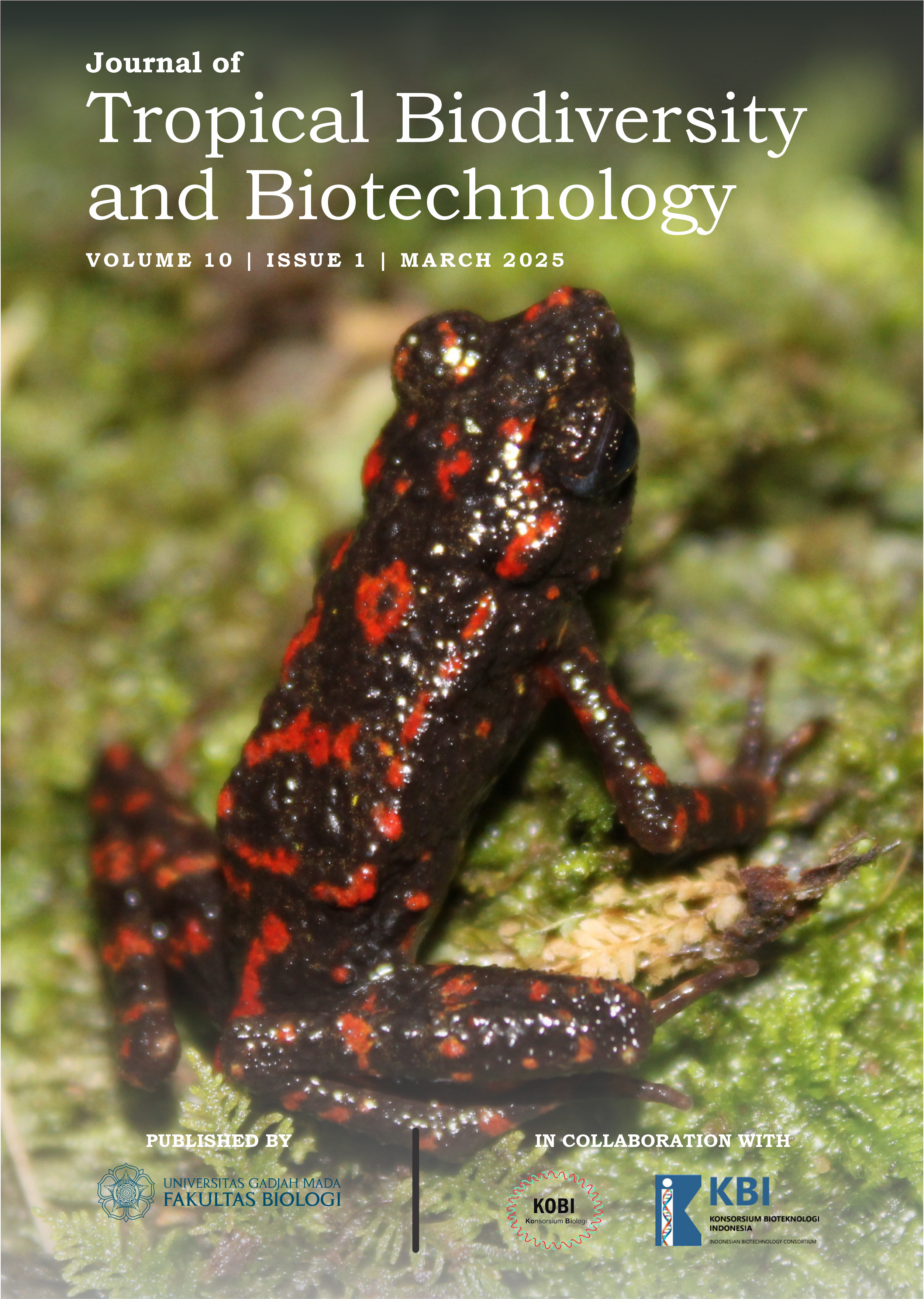New Report of Dysmicoccus brevipes Cockerell (1893) (Hemiptera: Pseudococcidae) on Heliconia sp., Lagenaria sp., and Zea mays L. Root in Bali Indonesia
Abstract
The pink pineapple mealybug, scientifically known as Dysmicoccus brevipes (Cockerell) (Hemiptera: Pseudococcidae), can associate with all part of the plant, including the roots. Additionally, it plays crucial role as a carrier of plant viruses, highlighting its importance in relation to host plants. Reports of D. brevipes infestations on above-ground plant parts in Indonesia have been documented since 1917. However, there is a lack of data on the infestation of subterranean plant parts or roots by this organism which highlights the significance of this research. This article presents the identification of mealybugs on the roots of Heliconia sp., Lagenaria sp., and Zea mays L. from Bali, Indonesia, using a morphological method based on determination keys by Williams (2004) and a molecular method based on the MtCOI gene. The findings of this study suggested that the species observed on all three host plants was D. brevipes, making it the most recent record of D. brevipes presence on Heliconia sp., Lagenaria sp., and Z. mays roots in Bali, Indonesia.
References
Adus, E.H. & Pu’u, Y., 2021. Populasi Dan Tingkat Serangan Hama Kutu Putih Dysmicoccus brevipes (Hemiptera : Pseudociccidae) Pada Tanaman Jahe (Zingiber officinalle Rosc) Di Desa Nuamuri Kecamatan Kelimutu [Population and level of attack by mealybugs Dysmicoccus brevipes (Hemiptera: Pseudociccidae) on ginger plants (Zingiber officinalle Rosc) in Nuamuri Village, Kelimutu District]. AGRICA, 14(1), pp.59–66. doi: 10.37478/agr.v14i1.1037.
Agricultural Quarantine Center Test Laboratory of Indonesia, 2016. Instruksi Kerja Metode (Identifikasi Kutu Putih secara Morfologi).
Akhsan, N. & Dewi, R., 2024. Wilt Disease Intensity of Pineapple Plants (Ananas comosus L. Merr) (Pineapple Mealybug Wilt-Associated Virus (PMWaV)) in Sub-District of Samboja. Proceeding 2nd International Conference Khairun University (IConKU), 1(1), pp.49–56.
De Barro, P.J., 1995. Bemisia tabaci Biotype B: A Review of Its Biology, Distribution and Control Technical., Canbera.
Beardsley, J.W., 1992. The pinapple mealybug complex; taxonomy, distribution and host relationship. International Pineapple Symposium, pp.334:383-386.
Daane, K.M. et al., 2012. Biology and Management of Mealybugs in Vineyards. In Arthropod Management in Vineyards:. Dordrecht: Springer Netherlands, pp. 271–307. doi: 10.1007/978-94-007-4032-7_12.
Dharmayanti, N.L.P.I., 2011. Filogenetika molekuler: metode taksonomi organisme berdasarkan sejarah evolusi [Molecular phylogenetics: a method of taxonomy of organisms based on evolutionary history]. Wartazoa, 21(1), pp.1–10.
Doyle, J.J. & Doyle, J.L., 1987. A rapid DNA isolation procedure for small quantities of fresh leaf tissue. Phytochemical Bulletin, 19(1), pp.11–15.
Franco, J.C., Zada, A. & Mendel, Z., 2009. Novel Approaches for the Management of Mealybug Pests. In Biorational Control of Arthropod Pests. Dordrecht: Springer, pp. 233–278. doi: 10.1007/978-90-481-2316-2_10.
Graham, M.W.R.V., 1983. Madeira Insects: Faunal Notes, Additions and Descriptions of New Species of Chalcidoidea (Hymenoptera). Boletim do Museu Municipal do Funchal, 35(151), pp.5–40.
Hebert, P.D.N. et al., 2003. Biological identifications through DNA barcodes. Proceedings of the Royal Society of London. Series B: Biological Sciences, 270(1512), pp.313–321. doi: 10.1098/rspb.2002.2218.
Jansen, M., 1995. Rhizoecus hibisci: a new pest in Dutch greenhouses 177th ed., Verslagen en Mededlingen Plantziektenkundige Dienst Wageninen.
Kalshoven, L.G.E., 1981. The Pests of Crops in Indonesia P. Van Der Laan, ed., Jakarta: PT. Ichtiar Baru - Van Hoeve.
Lisnawita, L. et al., 2023. The vector of Pineapple Mealybug Wilt-associated Virus (PMWaV) in Sipahutar pineapples in North Tapanuli, Indonesia. Biodiversitas Journal of Biological Diversity, 24(7), pp.4052-4059. doi: 10.13057/biodiv/d240743.
Matile-ferrero, D. & Étienne, J.F., 2006. Cochenilles des Antilles Françaises et de quelques autres îles des Caraïbes (Hemiptera: Coccoidea). Revue Française d'Entomologie, 28(4), pp.161-190.
Morales, M.G. et al., 2016. ScaleNet: a literature-based model of scale insect biology and systematics. Database, 2016, bav118. doi: 10.1093/database/bav118.
Nurbaya, S. et al., 2022. Morphological and Molecular Identification of Mealybugs on Mangosteen Fruits in Registered Packaging Houses on The Bali Island. International Journal of Agricultural Technology, 18(6), pp.2497–2508.
Park, D.-S. et al., 2011. DNA barcodes for two scale insect families, mealybugs (Hemiptera: Pseudococcidae) and armored scales (Hemiptera: Diaspididae). Bulletin of Entomological Research, 101(4), pp.429–434. doi: 10.1017/S0007485310000714.
Ptaszyńska, A.A. et al., 2012. Application of COI Sequences in Studies of Phylogenetic Relationships Among 40 Apionidae Species. Journal of Insect Science, 12, 16. doi: 10.1673/031.012.1601.
Saitou, N. & Imanishi, T., 1989. Relative Efficiencies of the Fitch-Margoliash, Maximum-Parsimony, Maximum-Likelihood, Minimum-Evolution, and Neighbor-joining Methods of Phylogenetic Tree Construction in Obtaining the Correct Tree. Molecular Biology and Evolution, 6(5), pp.514–525. doi: 10.1093/oxfordjournals.molbev.a040572.
Sartiami, D., 2006. Keberadaan Dysmicoccus brevipes (Cockerell) (Hemiptera: Pseudococcidae) sebagai Vektor Pineapple Mealybug Wilt-Associated Virus (PMWAV) pada Tanaman Nanas. Jurnal Ilmu Pertanian Indonesia, 11(1), pp.1–6.
Sartiami, D. et al., 2016. New Indonesian Country Records and Species Information for Mealybugs (Hemiptera: Pseudococcidae) in Wirjati’s Historic Collection. Redia, XCIX, pp.155–161. doi: 10.19263/Redia-99.16.20.
Setiawati, W., Budiarto, B.K. & Gunaeni, N., 2007. Preferensi Beberapa Varietas Tomat dan Pola Infestasi Hama Kutu Kebul serta Pengaruhnya terhadap Intensitas Serangan Virus Kuning. Jurnal Hortikultura, 17(4), pp.374–386. doi: 10.21082/jhort.v17n4.2007.p%p
Sudiarta, I.P. et al., 2023. A New Report of Moss-Camouflaging Mantis Nanomantinae in Bali, Indonesia. Journal Tropical Plant Pests and Disease, 23(2), pp.1–6. doi: 10.23960/jhptt.2231-6.
Tamura, K., Stecher, G. & Kumar, S., 2021. MEGA11: Molecular Evolutionary Genetics Analysis Version 11. Molecular Biology and Evolution, 38(7), pp.3022–3027. doi: doi.org/10.1093/molbev/msab120.
Williams, D.J., 2004. Mealybugs of Southern Asia, Southdene.
Williams, D.J. & Granara de Willink, M.C., 1992. Mealybugs of Central and South America, Wallingford, UK: CAB International.
Williams, D.J. & Watson, G.W., 1988. The Scale Insects of The Tropical South Pacific Region, Part 2, The Mealybugs (Pseudococcidae), Wallingford, UK: C.A.B International Institute of Entomology.
Yan-biao, H. et al., 2014. The occurrence of two species of pineapple mealybugs ( Dysmicoccus spp.) (Hemiptera: Pseudococcidae) in China and their genetic relationship based on rDNA ITS sequences. Caryologia, 67(1), pp.36–44. doi: 10.1080/00087114.2014.891698.
Zarkani, A. et al., 2023. Studies on mealybugs (Hemiptera: Pseudococcidae) in Indonesia, with description of a new species and three new country records. Zootaxa, 5228(2), pp.157–172. doi: 10.11646/zootaxa.5228.2.4.




